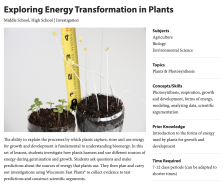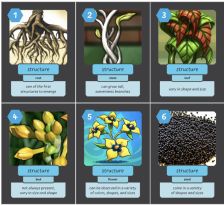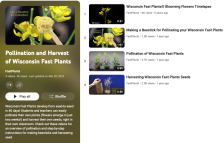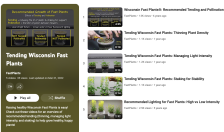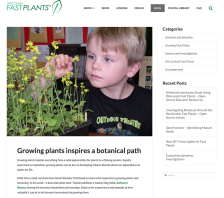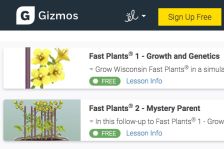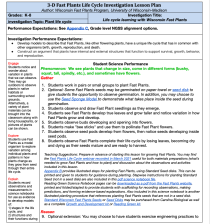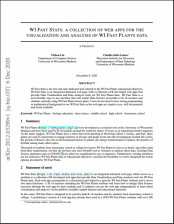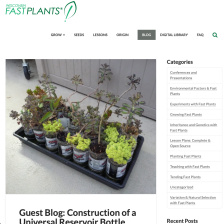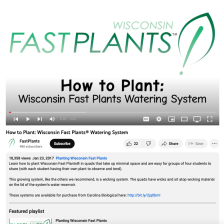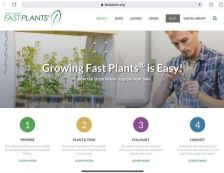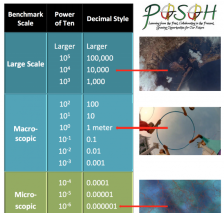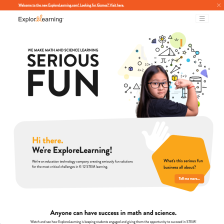Browse Resources
(8 classifications) (41 resources)
Resources | |
|---|---|
In this set of lessons and Fast Plants experiment, students investigate how plants harness and use different sources of energy during germination and growth. Students ask questions and make predictions about the sources of energy that plants use. They then plan and carry out investigations using...
This activity is designed for teaching the functions of basic plant structures. The activity uses two types of matching cards containing either
a) Structures - depictions of plant structures
b) Functions - descriptions of the function of plant structures
Using the downloadable PDF (including...
Preparing Your Students for the Future: Undergraduate Research Experiences with RapidCycling BrassicThis article with practical instructions about using Fast Plants in undergraduate research experiences was published as an addendum to a workshop given at the 2017 ABLE Conference in Madison, WI. Contains ideas for helping students at high school and undergraduate levels to conduct independent...
This YouTube playlist curated by the Wisconsin Fast Plants Program provides an overview and then demonstrates how to pollinate and harvest seeds from Fast Plants.
This YouTube playlist curated by the Wisconsin Fast Plants Program provides an overview and then demonstrates recommended tending (thinning, managing light intensity, and staking) to help grow healthy, happy plants!
This YouTube playlist curated by the Wisconsin Fast Plants Program provides an overview and then demonstrates planting Fast Plants in three wicking growing systems that are recommended for growing Fast Plants. Two of the recommended systems are built from easily found recycled plastic containers:...
This blog post on the Fast Plants website discusses the concept of plant blindness (the inability to see or notice the plants in one's own environment) and the importance of ending plant blindness and supporting plant vision. Fast Plants are an effective introduction to growing and noticing plants:...
This blog post on the Fast Plants website shares content from podcaster, Matt Candeias, host of the In Defense of Plants podcast. In an interview with Mary Williams of the American Society of Plant Biologists, Matt discusses the important connection fostered between physical experiences and...
This blog post shared on the Wisconsin Fast Plants website is a guest post by Daniel Murphy, author of the weekly blog Awkward Botany. In this post, Daniel shares his firsthand account of his experiences growing plants and becoming "a bona fide plant nerd." This post is a great example of the value...
This blog post on the Wisconsin Fast Plants website features the recently released Wisconsin Fast Plants genetics simulations, powered by ExploreLearning Gizmos. Sign up for a free account on the Gizmo website (https://www.explorelearning.com/index.cfm?method=Controller.dspFreeAccount) for free...
This blog post from the Fast Plants team addresses the question "can bee sticks sting?" (no, bee sticks cannot sting) and provides information on the use of bee sticks for pollination of Fast Plants in the classroom.
This investigation begins with a phenomenon that is evidenced in most every produce aisle: Many of the vegetables that botanists classify as Brassica look and taste different. This investigation aligns with middle and high school Next Generation Science Standards as well as with agricultural science...
This comprehensive Open Source lesson plan is designed for Kindergarten through Middle School level students to learn about life cycles, plants needs, and plant structures & their functions through hands-on investigations with Wisconsin Fast Plants. Depending on the grade level, students engage at...
WI Fast Stats is a browser-based data analysis and visualization tool that can be used alongside Wisconsin Fast Plants. WI Fast Stats has a set of R-developed unique web apps that corresponds to specific WI Fast Plants webinars and dataset (such as Cotyledon, or Ecosystem), to make data analysis...
This 5-page article is written by Yizhou Liu and Claudia Solis-Lemus and introduces Wisconsin Fast Stats, a collection of R-developed web apps of data analysis and visualization tools for educators that accompany learning activities from Wisconsin Fast Plants. The article covers topics such as...
This blog post, written by Joel Cryer of Bottle Biology, provides instructions to construct an inexpensive, self-watering planter that can be used to grow Wisconsin Fast Plants. The blog covers the materials and tools needed, as well as step-by-step instructions to create a universal reservoir...
This video is provided by Wisconsin Fast Plants, and demonstrates how to plant Fast Plant seeds using a quad-planter and wicking reservoir system. The video gives an overview of the materials necessary to grow plants with this method, and also provides step-by-step instructions guiding the process....
Part of the Fast Plants website, the "Grow" section offers complete instructions for preparing to grow, planting, tending, pollinating, and harvesting Wisconsin Fast Plants seeds. Instructions include text descriptions, photos, videos, and PDF instructions that can be downloaded, including a...
This is a printable poster resource developed by a collaboration of educators in the POSOH Project for teaching about systems and scale. This poster correlates with an excerpt from the video Cosmic Voyage about systems and scale, narrated by Morgan Freeman. A debrief discussion of that video excerpt...
Sign up for a free account on the Gizmo website (https://www.explorelearning.com/index.cfm?method=Controller.dspFreeAccount) for free access to two simulations that were collaboratively developed by the teams at Explore Learning and the Wisconsin Fast Plants Program of the University of...
| |
| Next → | |
